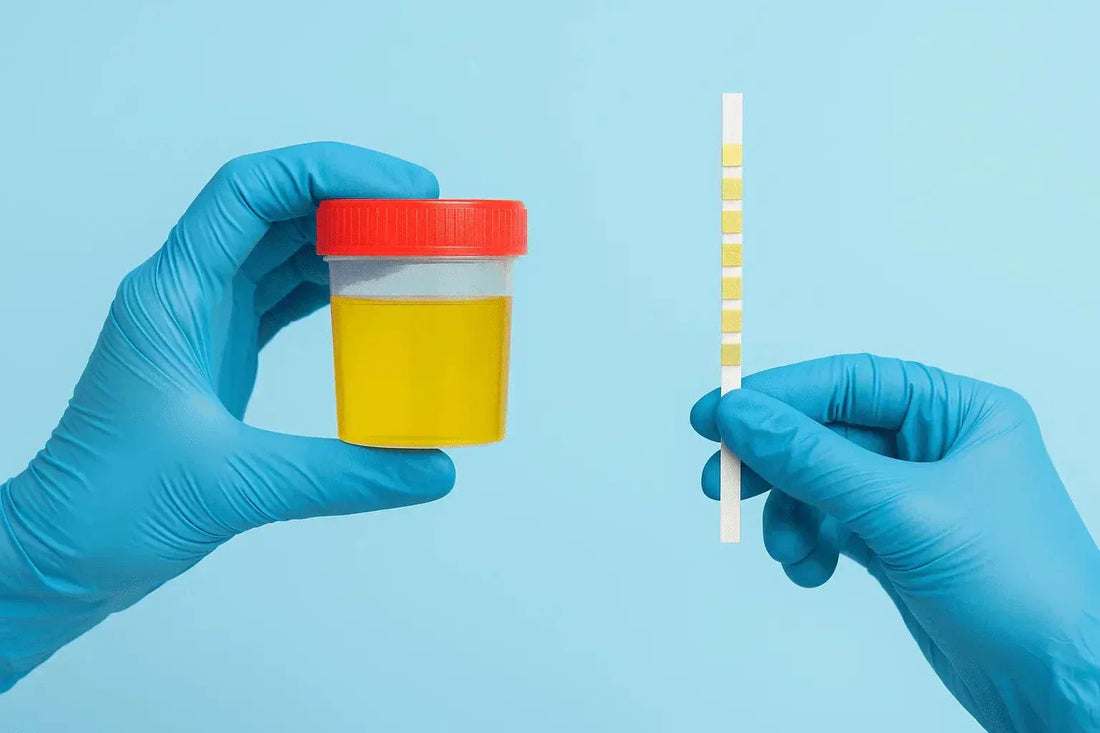Urine Test Strips for Protein: Results, Accuracy: When to See a Doctor
 Written By
Abel Tamirat, MD
Written By
Abel Tamirat, MD

If you've recently taken a urine test and noticed “protein” mentioned in your results—or you’re wondering whether to test at home—you're in the right place. This guide breaks down what urine test strips for protein actually do, how to use them correctly, and what your results might mean.
Whether you're managing kidney health, monitoring diabetes, or just looking for peace of mind, understanding how protein testing works can empower you to take the next best step.
What are Urine Test Strips for Protein
Urine test strips—also known as dipsticks—are a quick, non-invasive way to check for various substances in your urine. One of the most common and important substances tested is protein, specifically a type called albumin.
In healthy individuals, urine should contain very little to no protein. When protein shows up, it may signal that your kidneys aren't filtering properly. Protein in urine (called proteinuria) isn’t always a cause for concern—but in some cases, it can point to early signs of kidney damage, high blood pressure, or even diabetes-related complications.
According to the National Kidney Foundation, more than one in seven adults in the U.S. have chronic kidney disease (CKD), and many of those cases are caught when routine urine tests show elevated protein levels.
Learn more about urine protein test strips and how to use them in our detailed guide.
When and Why You Might Need to Use Protein Test Strips
You might consider using urine test strips at home if you:
-
Have diabetes or high blood pressure (both increase the risk of kidney issues).
-
Are taking medications that can impact kidney function (like NSAIDs or certain antibiotics).
-
Experience swelling in your legs, ankles, or eyes.
-
Have a family history of kidney disease.
-
Notice changes in your urination patterns—such as foamy urine or frequent night-time urination.
Healthcare providers often recommend regular testing for people with diabetes or hypertension. The American Diabetes Association suggests annual urine testing for all people with type 1 or type 2 diabetes, starting five years after diagnosis or sooner.
At-home test strips offer a convenient way to monitor changes between appointments or to alert you to something unusual that may need further evaluation. If you’re a parent, it's also helpful to understand protein in kids’ urine and how to handle early signs in children.
How to Prepare for a Urine Test Strip Analysis
Testing at home doesn’t require special equipment, but following a few guidelines ensures accurate results:
-
Hydrate normally: Avoid overhydrating before the test, as this can dilute protein concentration.
-
Use the first morning urine: It's usually more concentrated and provides clearer results.
-
Avoid testing during menstruation: Blood contamination can skew the protein reading.
-
Clean the area: Use a sterile wipe before urinating to prevent contamination.
If you're testing for the first time, it's a good idea to read the instructions on the test kit thoroughly. Some test strips also check for multiple markers like glucose, ketones, and pH—so make sure you focus on the protein indicator if that’s your primary concern.
Some test strips also check for multiple markers like glucose, ketones, and pH. For example, if glucose appears in your urine, you may want to review urine glucose levels and what they mean.
How to Use Urine Test Strips for Protein
Using the strips is straightforward, but timing and handling are key:
-
Collect a midstream sample: Urinate a little, pause, then collect the sample midstream in a clean cup.
-
Dip the strip: Submerge the test strip into the urine for the time indicated (usually 1–2 seconds).
-
Wait and read: Let the strip sit flat for about 60 seconds. Then compare the color on the protein pad to the chart provided.
The color chart typically ranges from negative (no color change) to trace, +1, +2, or higher. The deeper the color, the more protein is likely present.
Tip: Be sure to read the strip within the recommended time window. Waiting too long may result in inaccurate readings.
You can also refer to our full guide on at-home urine protein tests to understand your results better.

Take Control of Your Health
Get fast, reliable results from home with our at-home urine test kits. No clinic visits, just clarity and confidence.
What to Expect After the Test
Once you’ve completed the test:
-
Record the results in a notebook or health tracking app, especially if you're testing regularly.
-
If the strip shows “negative” or “trace”, that’s typically normal. Occasional traces may occur due to factors like stress, dehydration, or exercise.
-
If you see a persistent +1 or higher on repeated tests, it’s best to follow up with your healthcare provider.
False positives or negatives can happen, so one reading isn’t a diagnosis. Instead, it’s a signal to gather more information.
If you’re managing conditions like diabetes, you might also benefit from monitoring glucose at home.
Understanding Urine Protein Test Strip Results

Here's what each result level might mean:
-
Negative: Normal. No detectable protein.
-
Trace: May be normal, especially after physical activity or stress. Retest in a few days.
-
+1 (30 mg/dL): Low but potentially abnormal. Consider retesting or speaking with a doctor.
-
+2 to +4 (100–2000 mg/dL): High levels. This could indicate kidney inflammation, glomerulonephritis, diabetic nephropathy, or other serious conditions.
If you're unsure whether your protein reading is significant, it helps to compare it with the normal urine protein/creatinine ratio, which offers a more accurate snapshot of kidney health.
Accuracy and Limitations of Urine Test Strips
Urine test strips are helpful for screening, but they’re not foolproof:
Pros:
-
Convenient and fast (results in under 2 minutes)
-
Inexpensive and widely available
-
Good for routine monitoring
Limitations:
-
They measure albumin only, not total protein.
-
Results can vary based on urine concentration or pH.
-
Strips are less sensitive than lab-based tests like ACR.
In one clinical study published in BMC Nephrology, urine dipsticks showed 90–95% accuracy for detecting higher protein levels, but were less reliable for mild or early-stage proteinuria—often underestimating actual values in people with early kidney disease.
Environmental factors like humidity, expiration dates, and user error (timing or interpretation mistakes) can also affect results.
If you're unsure how to proceed after repeated positives, consider lab tests like the 24-hour urine collection for more reliable results.
What to Do If Your Results Show Protein in Urine
If your test shows elevated protein, here’s a step-by-step plan:
-
Don’t panic: One positive doesn’t confirm kidney disease.
-
Repeat the test: Try testing at the same time the next morning.
-
Note any symptoms: Swelling, fatigue, or high blood pressure? Document them.
-
Avoid heavy exercise or dehydration before retesting.
If protein levels remain high on repeat tests or if you have symptoms, schedule a medical evaluation. Your provider may order:
-
Urine albumin-to-creatinine ratio (ACR)
-
24-hour urine protein test
-
Blood tests for kidney function (like serum creatinine or eGFR)
-
Ultrasound to check kidney structure
Early intervention can help prevent long-term damage. Kidney disease is often silent in the early stages, so it’s important not to delay care if protein persists in your urine.
Special Considerations
For people living with diabetes:
The kidneys work harder when blood sugar is poorly controlled. Over time, this stress can cause leaks of protein into the urine—a condition called diabetic nephropathy. Annual testing is critical, even if you feel fine.
During pregnancy:
Protein in urine may indicate preeclampsia, a potentially dangerous condition marked by high blood pressure and kidney stress. If you’re pregnant and see +1 or higher protein on a test strip, contact your OB-GYN immediately.
In athletes:
Strenuous exercise can temporarily raise protein levels in urine (known as exercise-induced proteinuria). It usually resolves within 24–48 hours.
With infections or fever:
UTIs and systemic infections may also cause temporary proteinuria. If this applies to you, wait a few days and retest.
When to Use Home Test Strips vs. Lab Testing

Home test strips are best when:
-
You're monitoring an ongoing condition (like diabetes or hypertension).
-
You want to check on swelling or blood pressure changes.
-
You’re in between lab appointments and need reassurance.
Lab testing is better when:
-
You’ve had repeated +1 or higher results.
-
You have symptoms like fatigue, swelling, or changes in urine color.
-
You’re starting a new medication that may impact your kidneys.
-
You’re pregnant or have a chronic condition that needs deeper assessment.
Home testing is a great first step, but lab work gives a clearer and more complete picture.
When to See a Doctor
You should speak with a healthcare provider if:
-
You have repeated trace or positive results.
-
You’re noticing swelling, fatigue, or unusual urine changes.
-
You have high blood pressure or diabetes and haven’t had a recent urine test.
-
You’re pregnant and your test strip shows protein.
-
You’re unsure how to interpret your results or what to do next.
Kidney issues often progress slowly and silently. The sooner you identify changes, the more options you have for management or reversal.
Takeaway
Protein urine test strips are a quick, easy way to monitor your kidney health. While not diagnostic on their own, they can signal early signs of kidney stress—especially when used regularly and correctly.
Catching protein in your urine early gives you a chance to act before problems get worse. Pay attention to results, watch for symptoms like swelling or fatigue, and talk to a doctor if something seems off.
Ribbon Checkup makes staying on top of your health simple. Our at-home test kits are reliable, easy to use, and designed to help you feel confident in your next steps.
Your kidneys are vital—protect them early.
Explore our kidney health solutions today.
Related Resources
-
Urine Protein Test Strips: How to Use Them
A focused guide on using protein test strips correctly, interpreting color changes, and avoiding common errors. -
At-Home Urine Protein Test: A Complete Guide to Kidney Health Monitoring
Learn how to track protein levels from home, identify abnormal patterns, and know when to consult a provider. -
What Is the Normal Urine Protein/Creatinine Ratio? Its Importance in Kidney Health
Understand how lab-based ratios provide a clearer picture of kidney function compared to at-home dipsticks.
References
Clinic, C. (2023, September 10). A urine test for protein detects protein in your pee (urine). You might need this test as part of your annual checkup or if you have a family history of kidney disease. Retrieved May 31, 2025, from Cleveland Clinic website: https://my.clevelandclinic.org/health/diagnostics/12983-urine-protein-test
Morales-Brown, L. (2023, August 30). Why would a doctor recommend a urine protein test? Retrieved May 31, 2025, from Medicalnewstoday.com website: https://www.medicalnewstoday.com/articles/urine-protein-test#during-a-test
Queremel, D. A., & Ishwarlal Jialal. (2023, May). Urinalysis. Retrieved May 31, 2025, from Nih.gov website: https://www.ncbi.nlm.nih.gov/books/NBK557685/
Urine protein dipstick test: MedlinePlus Medical Encyclopedia. (2020). Retrieved May 31, 2025, from Medlineplus.gov website: https://medlineplus.gov/ency/article/003580.htm

Dr. Abel Tamirat is a licensed General Practitioner and ECFMG-certified international medical graduate with over three years of experience supporting U.S.-based telehealth and primary care practices. As a freelance medical writer and Virtual Clinical Support Specialist, he blends frontline clinical expertise with a passion for health technology and evidence-based content. He is also a contributor to Continuing Medical Education (CME) programs.




